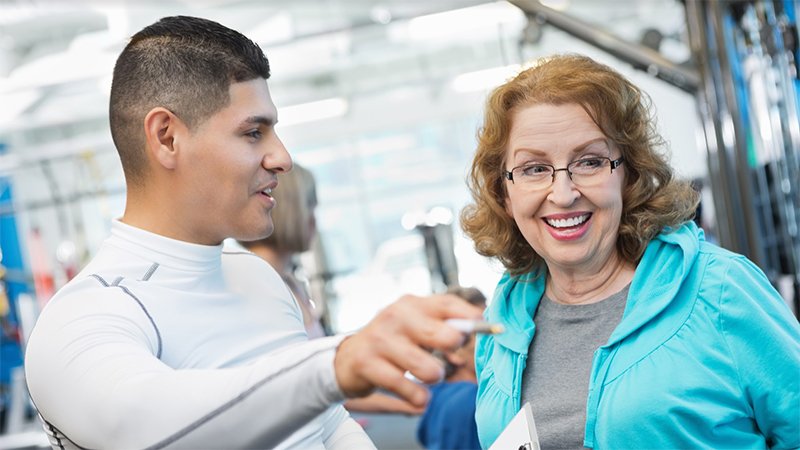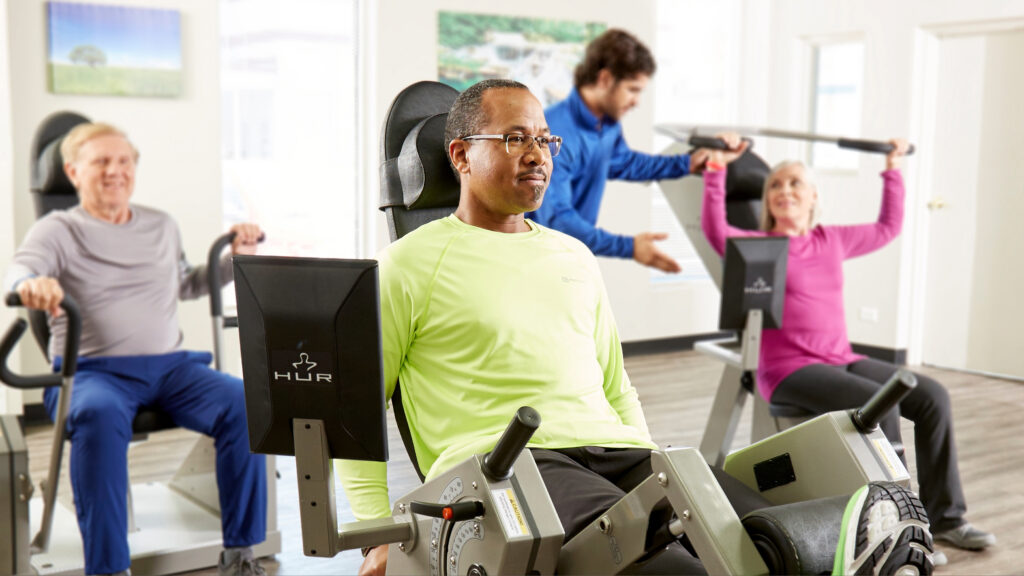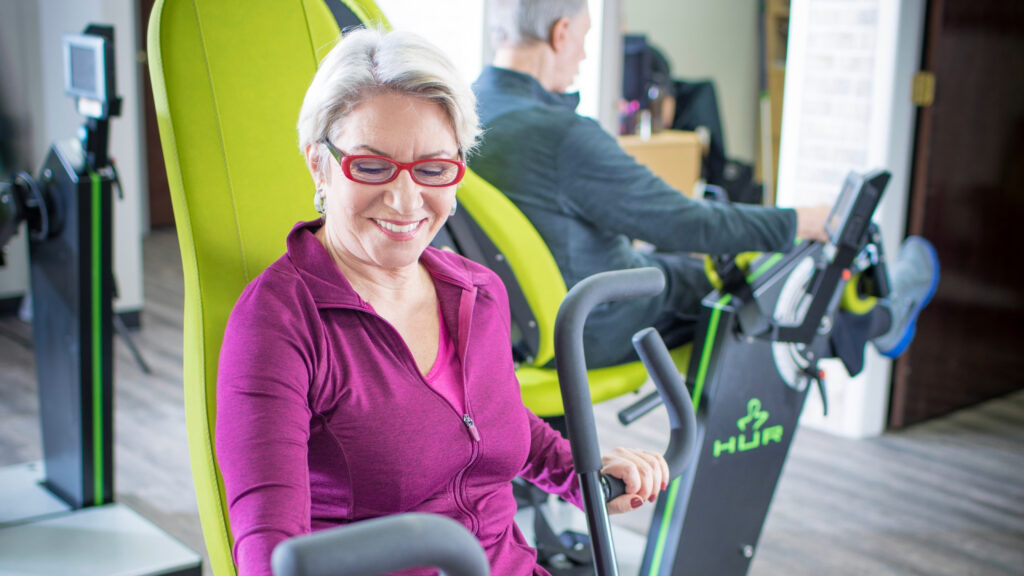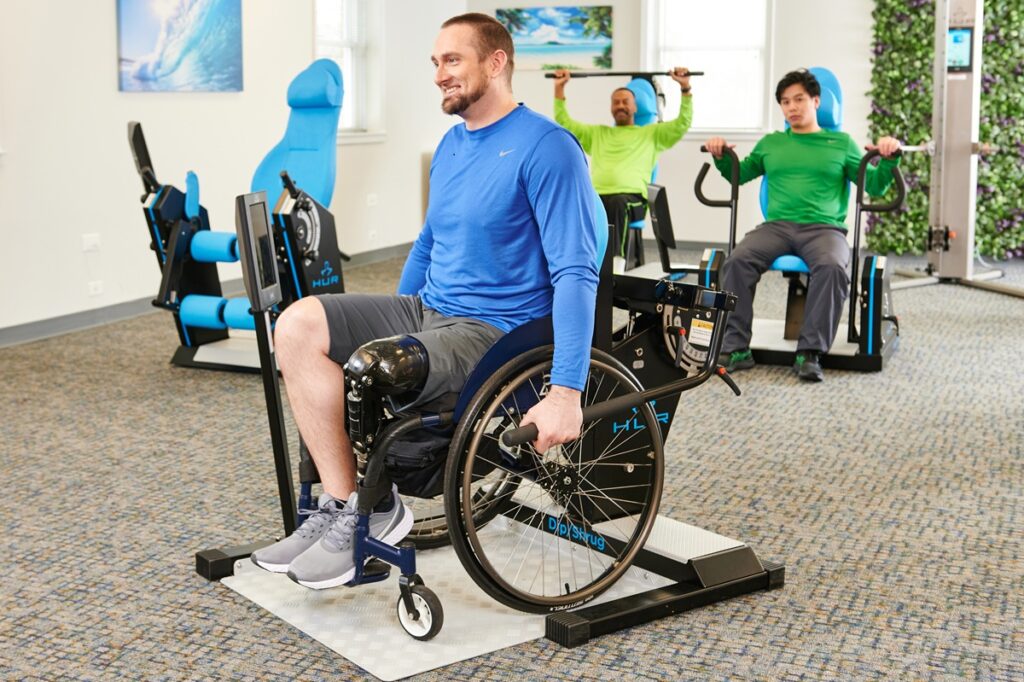"Older adults who strength trained at least twice a week had 46% lower odds of death for any reason than those who did not.” - US Department of Health and Human Services
There’s no question that baby boomers are changing the characteristics of what it means to be an older adult. Today’s retirees overwhelmingly believe that “health” is the #1 ingredient for a happy retirement and are much more likely to take charge of their health and health care than their parents’ generation.
Because boomers have a more empowered, proactive approach to active aging, forward-thinking senior living, active aging, and rehabilitation providers are rising to meet the needs this “next generation” demands for pro-actively aging and living well. Most are quickly discovering the importance of not only offering cardio and balance training, but strength training as well because seniors know that it’s a key component to a long, independent, active high-quality life.
Resistance training offers numerous benefits for seniors and is one of the best ways to avoid loss of muscle mass, build strength, and improve walking and mobility. Even though there are thousands of equipment options on the market, most fail to support the needs of older adults.
If you are a senior living professional interested in supporting the physical fitness requirements of older adults, there are 5 key features to look for when choosing strength training equipment:
- Pneumatic (Air-Resistance) Technology
- Computerized Technology
- Outcome Reporting
- Automated Progressive Resistance Equipment
- Built-In Safety Mechanisms
Let’s walk through each of these features and discuss why they are so important for seniors.
#1. Pneumatic (Air-Resistance) Technology
While traditionalstrength training machines rely on stacks of weights and a system of wires and pulleys to create resistance, pneumatic resistance machines use an air compressor to create a controlled amount of resistance that can be easily adjusted by the user. Users lift against that resistance, eliminating the need for actual weights.
In most cases pneumatic resistance machines are safer and more effective for users of all ages - but especially for older adults and those recovering from an injury. This is because pneumatic strength training equipment simulates the natural movement of muscle, providing safe and effective training through both low and high-speed movements. The level of resistance is adjusted in accordance with the muscles’ natural generation of force, allowing the user to train harder with less risk of injury.
Since air resistance adapts in accordance with the production of force, strength training with pneumatic technology is one of the safest ways to exercise. Limiting inertia means the user won’t swing backwards or forwards while moving through an exercise. This allows seniors to move smoothly through each exercise, reducing stress on joints, limbs and connective tissues.
The Key Benefits of Pneumatic Equipment:
- Lack of Inertia reduces stress on joints, limbs and connective tissues.
- Concentric and Eccentric muscle movements provide both positive and negative contractions with optimal loading throughout the range of motion.
- Close to Zero Starting Load supports all strength levels and abilities.
- 1/4lb (100g) Resistance Increments motivate beginners, celebrate progress and encourage early rehabilitative therapy.
- High-Speed Resistance Training is safely enabled by air resistance, which adapts in accordance with the production of force, regardless of the speed of movement.
- Safer Alternative to traditional weight stack machines.
- Virtually Silent machines provide a comfort- able, inviting and non-intimidating workout experience.
#2. Computerized Technology
Today’s seniors are embracing new technologies at a growing rate, learning how to incorporate them into their lives as a way of supporting their goals, intentions, and priorities. While most seniors today own a smartphone and desktop or laptop computer, many prefer to use a tablet because they are light, portable, and offer the ability to change the font size. Most importantly, seniors like the using a touch screen.
In addition to being familiar and easy to use, touch screen technology can streamline the exercise experience for both seniors and staff. By automating seat adjustments, weight, rep count, and other functions, and showing a user’s progress on an easy-to-use graphical interface, older adults can train safely and independently. This reduces the need for staff assistance and encourages consistent participation.
Touchscreen technology can also reduce the intimidation many seniors feel towards strength training by eliminating confusion about seat settings, the number of reps, and the amount of resistance to use.
Key Benefits of Technology Driven Strength Training Equipment:
- RFID Wristbands enable automatic user identification and sign-ins, providing training program activation with a single touch.
- Touchscreen Interfaces display animated workout instructions, customized settings, heart rate, progress visuals and individual goals.
- Pre-Set Equipment Adjustments automatically load the resistance, repetitions, lever arm placement and seat height for each user to encourage independent training.
- Automatic Resistance Increases support users’ progression based on their personal training plans and milestones.
- Reduced Wait Times thanks to automated equipment and efficient circuit formats.
- Equipment-Free Exercises can be tracked with paper-free recording, easy-to-follow instructions and automated user-synchronization.
- Application/Software Integration enables importing and exporting of user information and program details.
#3. Outcome Reporting
“The data is very motivating for our residents. Even when they don’t feel like they’re making progress they can look at the screen and see that they are. The data is so powerful our trainers incorporate it into progress reports as a way to keep our residents motivated.”- Jan Olson, Fitness and Living Well Manager, Paradise Valley Estates
Tracking and reporting individual and program data is crucial for both motivating users and optimizing staff resources. But, tracking progress and compiling useful reports can be time-consuming and cumbersome for fitness staff who are already stretched too thin.
However, when outcome reporting is built into strength training equipment, tracking individual progress and displaying outcome reports is done automatically. Being able to clearly see progress from a touchscreen is a powerful motivator for consistent quality workouts. It also allows staff to create and manage their clients' training programs, monitor individual progress, and track outcomes across time and peer groups.
Data is automatically captured for each user, recording exercise and performance data; such as repetitions, resistance and progress. Reports can be generated on the progress of a group or a single user, making it easy to isolate and compile data for a wide range of purposes. This data can then be utilized in the development of greater wellness goals and initiatives.
Key Benefits of Automated Outcome Reporting:
- User-Friendly Progress Tracking helps fuel motivation and program adherence for older adults
- Automated Reporting stores benchmarking data, tracks key performance metrics of both individuals and the overall fitness center, measures equipment usage, records attendance/participation, and sends proactive alerts based on custom filters
#4. Automated Progressive Resistance
In order for seniors to build strength and prevent plateaus, they must continue to challenge muscles by slowly increasing resistance. When we train at the same level of resistance over time, muscles will maintain their current size and strength, but will not develop further. This is true for everyone at every age regardless of how active and healthy they are.
Progressive resistance training (PRT) is a strength training method where resistance is gradually increased as strength improves. There are many different types of resistance training equipment on the market, including standard weight-stack machines, pneumatic (air resistance) machines, hand-held weights, and elastic bands.
However, the best machines are engineered to automate resistance increases for the user based on their progress and custom training program. This automation assists the older adult in safely training independently, which encourages program adherence and reduces the need for staff assistance.
Key Benefits ofAutomated Progressive Resistance:
- Supports User Progression via automated resistance increases based on personal training plans and milestones.
- Easy-to-Use equipment encourages independent training and reduces the need for user assistance thanks to automated equipment and resistance adjustments.
- Prevents Plateaus by continually challenging muscles with slow resistance increases.
#5 Built-In Safety Mechanisms
Not all exercise equipment is built to support the needs of seniors. In fact, studies show that 29% of 60+ year-olds, and 46% of 80+ year-olds, are incapable of safely lifting 10lbs over their heads. With such challenges in mind, ergonomics and built-in safety mechanisms should be at the top of the list when deciding on strength training equipment for seniors.
When selecting strength training equipment with built-in safety features, look for manufacturers who maintain a certified quality system that follows ISO 13485:2003 and ISO 9001:2008 standards. Machines should be durable and engineered with upgradable features that will adapt to future advances in technology.
In addition, resistance training machines should include ergonomic details, such as accessibility features, adjustment options to accommodate different body types, ability levels, and age groups, and wide, comfortable seats.
Key Benefits of Built in Safety Mechanisms on Resistance Training Equipment:
- Built-in Safety with easy access hand grips, foot support and safety belts, reversible back supports and rollers (for easy on and off access), locking mechanisms, close to zero starting loads and small, incremental adjustment options.
- Range Limiters determine where a movement starts and ends and limits range of motion - particularly useful in rehabilitation applications.
- Floor Mounts and Anti-Tilt Plates secure equipment to the floor, prevent tilting, and
- Easy Access equipment options make equipment accessible for wheelchair exercisers.
- Touchscreen Adjustable Seats help users find a safe and effective training position.
